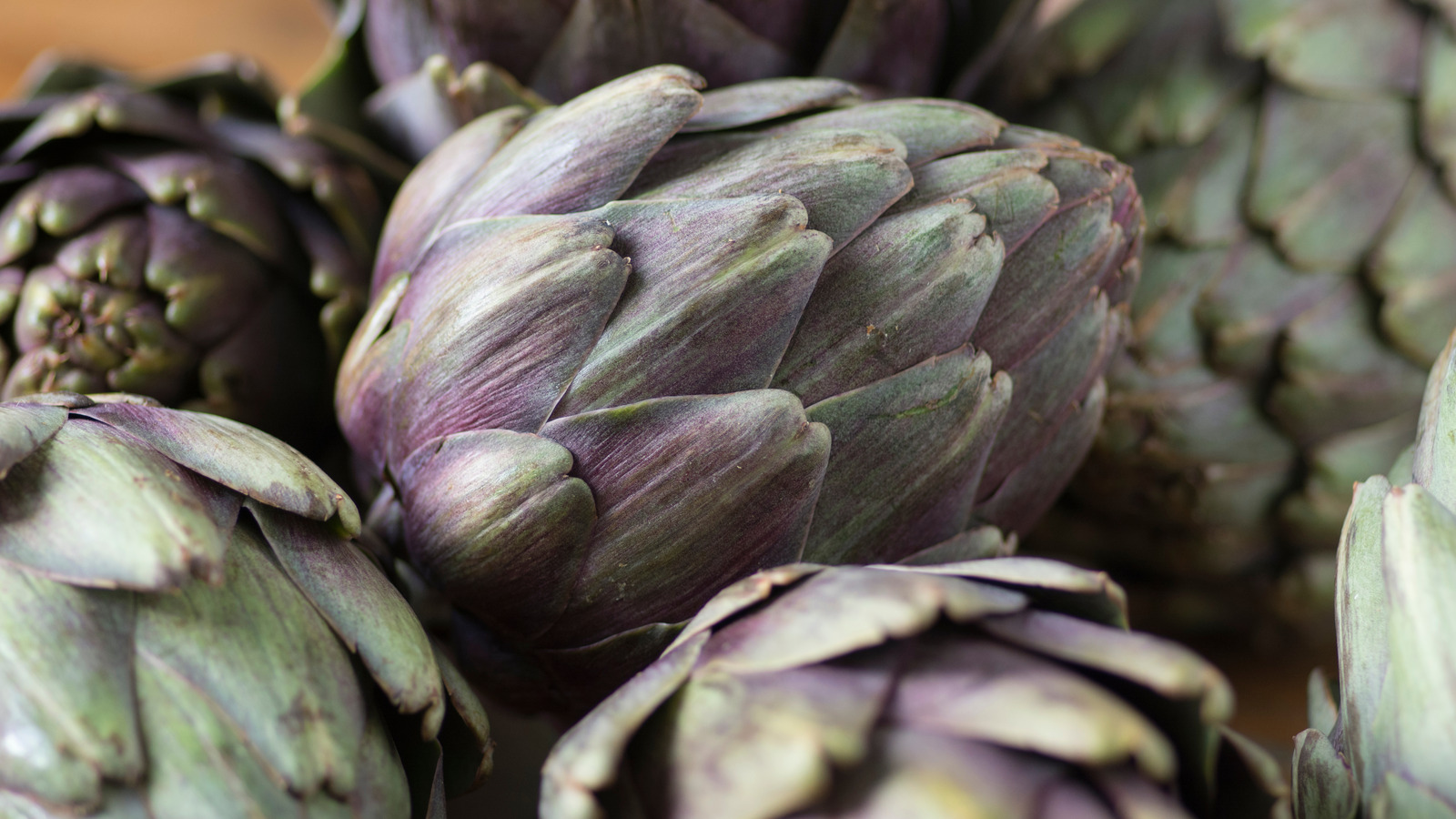
13 Mistakes You’re Making With Artichokes – Mashed
There are a number of fruits and vegetables you may be passing over in the grocery store as they appear overly complicated to cook, let alone cut into, and fresh artichokes are likely among them. While most commonly referred to as a vegetable in the culinary world, artichokes are actually a perennial thistle and are therefore technically a flower. If left unpicked, an artichoke will produce beautiful purple blooms in spring and summer.
With prickly leaves, a tough stem, and a squeaky exterior, this natural delicacy doesn’t come in the most user-friendly packaging. It can be daunting to eat, let alone prepare. But that doesn’t mean it isn’t worth the effort. Artichokes are delicious and tender when prepared properly, and are also packed with antioxidants, fiber, and nutrients like folate. By following a few simple tips, you’ll be an artichoke aficionado in no time. Here’s how to avoid common mistakes and pitfalls home cooks and foodies fall victim to so you can achieve the best outcome with your next artichoke experiment.
1. Not starting with a fresh artichoke
 David Silverman/Getty Images
David Silverman/Getty Images
As with any produce, the best place to start is with the freshest selection you can get your hands on. While picking out a fresh artichoke may not be as intuitive as picking out a perfectly ripe pear or slightly softened avocado, there are some obvious signs to look for that will make your next artichoke mission a breeze.
Start by holding the artichoke in your hand. It should feel dense and firm, while overripe artichokes are softer and lighter in weight. Next, take note of the leaves. They should be tightly wrapped around the artichoke, as opposed to soft and slightly opened. They should also make a squeaking sound as you rub your finger against them, which indicates they are in their prime for cooking. Apart from the leaves and density, don’t judge an artichoke by its cover too much. Unlike other fruits and vegetables, brown spots on the artichoke are not an indication that it’s about to go bad; they’re likely just frost marks. Avoid artichokes with active budding or a purple tinge; this coloring might look attractive, but is usually a sign of being past prime.
2. Not cooking artichokes when they’re in season
 snchzgloria/Shutterstock
snchzgloria/Shutterstock
Although it’s possible to purchase artichokes year-round, buying them when they’re in season will provide the best flavor outcome as well as the most nutritional benefits. Artichoke season lasts from March to June, though you can still find fresh artichokes throughout the summer and into fall. As the season progresses, you’ll notice artichokes in the grocery store slowly decrease in size. They may disappear from shelves in the winter, though you can usually still find preserved artichoke hearts.
Low in calories and high in nutrients, artichokes are best consumed when in season as they pack the most nutritional punch during the spring. If you’re lucky enough to live in California, cut out the middleman and buy directly from a local farmer near you. California boasts nearly 100% of artichoke agriculture in the country, and supporting your local farmers not only boosts your local economy and lowers your carbon footprint but also guarantees freshness and nutritional density.
3. Not rinsing your artichoke before cooking
 Jupiterimages/Getty Images
Jupiterimages/Getty Images
It’s common practice to rinse your fruits and vegetables before you cook or consume them, especially when they’re non-organic. It’s easy to assume you don’t have to rinse an artichoke since the edible portions are protected by the leaves and stem. However, there is a technique for rinsing artichokes that is a crucial step in the cooking process.
According to the Centers for Disease Control and Prevention, the rule of thumb is to wash all produce, even if it has leaves or a peel that you do not intend to eat, as bacteria can creep into the crevices of your produce, leaving you at risk for foodborne illnesses like salmonella. A gentle rinse also helps remove harmful pesticides, bugs, or soil that might’ve seeped into the crevices. With so many nooks and crannies between the leaves, it’s especially important to clean your artichoke before giving it a trim. Some chefs even fill a bowl with cold water and plunge the artichoke into it multiple times to help extract dirt.
4. Not trimming your artichokes
 Nito100/Getty Images
Nito100/Getty Images
Spiky and unapproachable-looking, artichokes are one of those foods that makes you wonder how anyone figured out it was edible. Thankfully, there is a time-tested method to the madness of artichoke preparation, and it really isn’t as complicated as the vegetable seems from the outside. Once you get the steps down, trimming and preparing an artichoke will seem like a breeze.
The first step is to trim off an inch or two from the stem. Some people still enjoy eating the interior of the stem, which will become tender after cooking it, but the end of the stem is usually tough and brown, so it’s best to give it a clean cut. Next, you’ll want to slice off the top of the artichoke, where many of the prickly leaves come together. Place the artichoke lengthwise on your cutting board, and use a serrated knife to trim off about one inch of the top. The last step is to de-thorn the leaves. Although this step is optional, it’s recommended to maximize a pleasant eating experience. Hold the artichoke by the stem in one hand and twist it around in a circular motion on your cutting board, trimming off all the tips of the leaves to remove the thorns. Your guests will certainly appreciate the extra care you take to finish the job.
5. Letting them brown
 barmalini/Shutterstock
barmalini/Shutterstock
As soon as you cut open any fruit or vegetable, oxidation immediately begins to occur, turning the exposed piece of the fruit or vegetable brown. Oxidation, aka enzymatic browning, naturally occurs when fruits and vegetables are exposed to air, which can affect both the color and taste of the fruit or vegetable. This is true for artichokes, but there are some tips and tricks to slow down or even prevent those unsightly brown spots from forming.
Some professional chefs might reach for ascorbic acid, otherwise known as vitamin C, to curb browning on freshly cut produce. As for the rest of us amateurs who may not have ascorbic acid on our shelves or in our Amazon carts, squeezing citrus such as a lemon directly onto your trimmed artichoke will do the trick. If you’re prepping several artichokes to cook at a later time, you’ll also want to soak them in an ice bath. After squeezing out all the juice, add the lemon carcass to the water for good measure.
6. Steaming artichokes without a steamer basket
 SingerGM/Shutterstock
SingerGM/Shutterstock
While it’s not against the artichoke rules to simply plop the whole bulb into a pot of boiling water, it’s not the most preferred method of cooking them. Boiling them on their own without a steamer basket means they’ll bob around, flipping in all directions as they cook, which doesn’t provide consistent cooking throughout the flower. There’s nothing worse than going through the labor of love that is cooking an artichoke only to have it come out undercooked on one side and overcooked on the other. The other problem with boiling artichokes sans a steamer basket is the artichoke is more prone to becoming waterlogged, which makes for a messy eating experience.
To avoid these common pitfalls, use a steamer basket and place the artichoke leaves facing down, with the stem pointed straight up. That will ensure steaming on all sides of the artichoke, including the heart, which is the best part of the artichoke experience. The larger your artichoke, the larger the steamer basket you’ll want to use to make sure you achieve even consistency.
7. Drying out the artichoke in the oven
 Jackf/Getty Images
Jackf/Getty Images
While roasting is a great method for cooking just about any vegetable, artichokes are more prone to drying out in the oven as they take a longer time to cook. For the most consistent and evenly cooked results, we’d recommend steaming the artichokes prior to roasting. However, if you’re determined to roast your artichoke without steaming it first, you’ll need to cut the artichoke in half lengthwise in order to give it the best chance at an even roast. Don’t forget to spoon out the hairy choke in the center of the artichoke after you cut it in half, as this part is inedible.
If your artichoke is coming out too crispy and burnt after being roasted, try lowering the temperature to around 375 degrees. While most experts agree the best temperature for roasting veggies is around 400 to 425 degrees, artichokes take considerably longer time to cook, so a low and slow method is best. You can always crank the broiler on at the end to achieve your desired crispness.
8. Undercooking artichokes
 barmalini/Shutterstock
barmalini/Shutterstock
On the one hand, artichokes are arguably a labor of love, as they take some time to prepare and even longer to cook. If you’re in a rush to get dinner on the table, this is not the flowery vegetable for you, as undercooking artichokes is almost as disappointing as undercooked chicken, though not nearly as dangerous to your health.
It’s nearly impossible to tell exactly when an artichoke is done based on a timer alone, as every artichoke is different in size as well as freshness, which both play a role in cooking times. The best way to know if your artichoke is ready is to taste the leaves every 15 minutes or so. The leaves closest to the stem are usually on the tougher side, so the best gauge is to reach for a leaf somewhere in the middle. If it pulls off easily and is tender at the base, the artichoke is ready to go. If it’s still tough and doesn’t yield much meat, continue roasting or steaming until you achieve the perfect tenderness.
9. Overcooking artichokes
 David Silverman/Getty Images
David Silverman/Getty Images
A common mistake in cooking an artichoke that’s even more disappointing than undercooking is overcooking, as you can’t take it back once it’s been blasted to mush. Continuing to taste the leaves as you cook is one way to avoid this common pitfall, but there are some other tips and tricks that many home cooks can put into practice.
If your preferred method of cooking your artichoke is in the oven, there are ways to avoid the overcooked, mushy mistake. Like most vegetables, artichokes will steam rather than roast when placed too close together on the pan, so be sure to give each half room to breathe. Speaking of pans, the best way to avoid overcooking your artichoke, or any veggie for that matter, is to use the right pan. Pans with tall, vertical sides like casserole dishes and cake pans don’t allow for the water to evaporate from the artichoke while roasting, leading to soggy, overcooked results. Instead, use a sheet pan lined with parchment paper.
If you’re steaming your artichoke in a steamer basket on the stove, check the leaves periodically for doneness, or poke a fork or knife into the stem. If it slides through like you’re poking a banana, it’s time to pull it off the burner and dig in.
10. Eating the wrong parts
 Nito100/Getty Images
Nito100/Getty Images
If you’ve never eaten an artichoke before, you may inadvertently start munching on parts that are not edible or appetizing. Once you understand how to pick them apart and enjoy them, you’ll be hooked on this tasty green flower. Although the inedible parts of an artichoke aren’t poisonous, they may cause digestive issues, so it’s best to know your way around the bulb.
Start at the base of the artichoke and peel back the leaves individually, scraping your teeth along the inside of the leaf to remove and enjoy the flesh. (You’ll also want to dip the leaves in a sauce of your choice.) The rest of the leaves are not edible, so discard those after you’ve eaten the meat. Once you’ve peeled back all the leaves, you’ll reach the heart of the artichoke. The purple, hair-like center is not edible, so be sure to scrape that out before or after cooking. The heart is where the leaves are all connected, and there will still be a large chunk of it left to devour. You may dip this in sauce, or sprinkle some salt and pepper on top, or eat it plain as is. It’s the sweetest and most hearty piece of the artichoke experience. Lastly, you can peel back the exterior of the stem and gobble down the fleshy interior.
11. Not pairing the artichoke with the right dip
 gresei/Shutterstock
gresei/Shutterstock
Seasoning your artichoke and dipping it in a perfectly paired sauce is half the fun in eating one. Before you serve your artichoke, you may want to sprinkle some salt and pepper on the inside and outside, then brush it with olive oil or butter to your liking.
Not all dipping sauces go well with an artichoke, but if you love barbecue sauce or hummus, there’s nothing wrong with going the unconventional route and sticking to what you like. Melted, salted butter is always a winner. Dipping sauces with bases like feta, cream cheese, or parmesan are also complementary flavors to artichoke flesh.
Oftentimes, chefs will pair the sauce depending on the size of the artichoke and the amount of time it takes to cook it. Smaller artichokes that take less time to cook can be paired with bold, bright flavors like olives or garlic. Larger artichokes that are cooked low and slow will yield less sweetness and pair better with mild flavors like hollandaise or sour cream.
12. Grilling the artichoke without cooking or seasoning it
 Marie Sonmez Photography/Shutterstock
Marie Sonmez Photography/Shutterstock
Summertime is a great season to give artichokes on the grill a try, as we all know a charred finish makes every vegetable taste better. Before you go throwing a whole artichoke on the grates, be sure to avoid some common mistakes found in grilling artichokes.
First, you’ll want to cook the artichoke all the way through before you slap it on the grill. Trying to cook an artichoke from start to finish on the grill is an excellent way to char all the flavor, moisture, and texture out of it, rendering it basically inedible. When you’re ready to grill your fully cooked artichoke, cut it in half and place the flesh side down on the grill to give the heart, stem, and inner leaves a nice char. You may flip it if need be, but since the outsides of the leaves aren’t digestible, it’s not necessary to char it on the outside. Lastly, make sure to oil the grill grates or the artichoke itself before placing it on the hot grates. While it’s better practice to oil the grates rather than the veggies, it’s perfectly acceptable to oil the artichoke since it won’t be spending much time on the grill and therefore won’t be as susceptible to burning.
13. Over-seasoning the artichoke
 Maica/Getty Images
Maica/Getty Images
To truly allow the artichoke to shine, we recommend going light on accompanying flavors so as not to overpower the sweet, subtle nuances of the artichoke meat itself. The most common go-to seasonings are salt and garlic, with a lemon squeeze, but you can also get creative depending on the cuisine you are serving it with.
For Greek or Italian style pairings, we suggest a feta cheese dip or sprinkle of Italian seasonings blend. If you’re serving the artichoke as part of an appetizer, allow it to shine on its own with just a squeeze of lemon and a melted butter dipping sauce. When adding it to the grill, a light oil such as canola can be used to give it a subtle flavor and keep it from sticking to the grates. If you enjoy a spicier flavor profile, give it a sprinkle of red pepper or cayenne for a kick of heat, but don’t go overboard as you don’t want to take away from the sweetness of the tender artichoke meat.


































